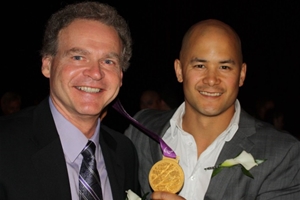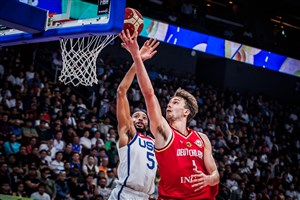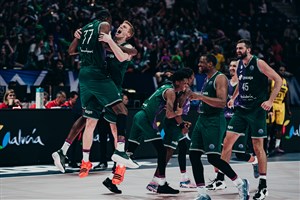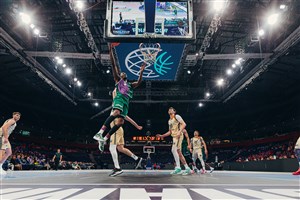
Choosing the right house for success
MELBOURNE (Paulo Kennedy's View from Downunder) - Don't look now, basketball is at the start of a worldwide boom, but that means hoops administrators around the globe will have to choose their houses wisely.
The inaugural FIBA Basketball World Cup in Spain in 2014 blew all its predecessors out of the water with its global reach. Last year's EuroBasket was played to record crowds and produced incredible drama, but even its reach was dwarfed by the ever-growing FIBA Asia Championship, which attracted 365 million TV viewers, almost double the figure from two years earlier. A record crowd of 12,000 watched the AfroBasket Semi-Final between Angola and host nation Tunisia, while more than 20,000 people in Mexico watched their team come perilously close to downing powerhouse Argentina in the FIBA Americas Championship Semi-Finals.
Domestically, the NBA continues to lead the way, capturing people's attention worldwide with slick presentation of their incredible athletes. The Euroleague continues to attract huge crowds, and soon the Basketball Champions League will add even more high-quality hoops to the European scene. Australia's NBL has got its act seriously together under new management, with a collective TV audience of more than two million so far this season and the league in discussions with counterparts in China and the Philippines about joining forces.
With these leagues going strong and FIBA's new calendar ready to roll in 2017, it means there will be international basketball and/or quality league hoops on show during the week, every week for about 10 months of the year. The question is where do you play these games? Is bigger better? In some cases it is.
The France v Spain EuroBasket Semi-Final in Lille was just amazing, with just under 27,000 people crammed in and providing an atmosphere that can't be topped and just wouldn't have been the same in a small stadium (27,372 spectators turned out three days later for the Final).
Australia's Boomers defeated New Zealand's Tall Blacks in front of more than 15,000 people at Rod Laver Arena in Melbourne, and the roof nearly came off when Patty Mills nailed a dagger three-pointer in the final quarter. Not only did the huge venue produce a brilliant atmosphere, it helped in restoring credibility to the sport Downunder.
The roofs off! 🏀 #FullHouse #WeAreMelbourne @MelbUnitedHQ pic.twitter.com/Q1JM9sp52f
— Peter Siddle (@petersiddle403) December 27, 2015
It's the same in league play too. The roof literally did come off - or open - when Melbourne hosted Perth in an open-air game on 27 December in front of 10,200 fans and the place rocked when Boomer Chris Goulding hit some huge shots in the fourth quarter.
The Wildcats can top that at Perth Arena, with crowds of 11,000 to 13,000 whipped into a frenzy when Jermaine Beal does things like this.
Beal hits his 8th 3 pointer tonight to equal his career high score #HardBall @PerthWildcats @MelbUnitedHQ https://t.co/5FYvyhVYq8
— NBL (@NBL) December 10, 2015
I'm sure you get the point. Basketball can be something special when the best teams fill the best stadiums and put on a show. But does that mean we should have a one size fits all approach?
Many years ago, the NBL put in a minimum stadium capacity clause, but all that really achieved was making some teams play in expensive stadiums that were barely half full, the atmosphere drained away by all the dead air. Once that 5,000-seat requirement was lifted, teams playing in smaller venues provided an atmosphere that captured the imagination and brought the fans back.
Anyone who read last week's column would have seen the Ekene Ibekwe-inspired pandemonium at the North Shore Events Centre, one of the most intense venues I’ve ever watched basketball in. The story is similar in Cairns, where 5,000 people created one of the biggest dins ever hear in the Far North when Ron Dorsey forced the 2011 Grand Final to overtime.
The Wildcats used to regularly fill the 4,000-seat Challenge Stadium, helping them build a product that now almost fills a cavernous arena. Similarly, New Zealand and Melbourne played in small and loud venues that showcased the game night experience, and then transitioned gradually to bigger, city centre arenas where they are now a popular ticket. Sydney have recently moved to a smaller venue, not by choice, and been rewarded with crowds of a similar size producing a much better game-night experience and home-court advantage.
The story is the same internationally. No one in Wellington for Game 2 of the 2009 FIBA Oceania Championship will ever forget the atmosphere when the Tall Blacks sprung a stunning upset.
Likewise, the Chinese Basketball Association (CBA)'s choice of an intimate 6,000-seat stadium for last year's FIBA Asia Championship in Changsha was inspired. When Yi Jianlian was rocking the rim, the crowd was rocking the gym.
It all comes down to picking your audience.
My question to national basketball federations ahead of the new FIBA Calendar is this: which match-ups will the public consider to be big-ticket items?
Perhaps Australia facing China could demand big-time promotion to fill a big stadium, but a game against lower-ranked Japan might be perfect for a regional city which can provide a bumper atmosphere?
It's the same for domestic leagues. No one likes to see lots of empty seats. Former NBL CEO Fraser Neill was wise when he campaigned for mid-week games to be played in smaller venues closer to people’s homes. Less people needed to provide atmosphere, less travel time to deter fans from going.
Early this season, many NBL games on a 'school night' were notable for their empty seats, midweek sport something that has experienced quite the pushback in this country. Of course once the holidays hit, it seems every game is a sell-out or thereabouts regardless of what day it's on.
There are lessons to be learned about choosing the right house for the right game and it's important the folks at Basketball Australia and Basketball New Zealand are paying attention.
Fill the house, whether great or small, and the new international calendar will be successful. Slowly but surely more games will attract big-ticket status. Choose the wrong house and the perception will be poor, the rent will be costly and international hoops Downunder could be chasing its tail again after finally getting things right.
Paulo Kennedy
FIBA
FIBA's columnists write on a wide range of topics relating to basketball that are of interest to them. The opinions they express are their own and in no way reflect those of FIBA.
FIBA takes no responsibility and gives no guarantees, warranties or representations, implied or otherwise, for the content or accuracy of the content and opinion expressed in the above article.to Rio.

















